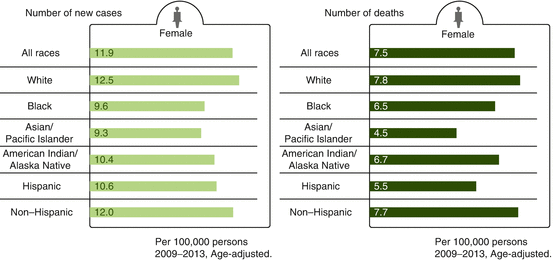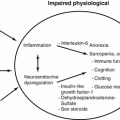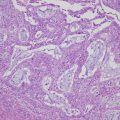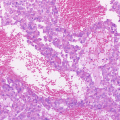Type
<20 years
20–50 years
>50 years
Coelomic epithelium
29%
71%
81%
Germ cell
59%
14%
6%
Specialized gonadal stroma
8%
5%
4%
Non-specific mesenchyme
4%
10%
9%
Some patients with ovarian cancer have a positive family history or genetic background, and the disease is called familial ovarian cancer in a broad sense if a patient has a relative with ovarian cancer. If a patient has a family history of ovarian cancer in close relatives or a number of relatives with this cancer, it is called familial or hereditary ovarian cancer, including hereditary breast and ovarian cancer (HBOC) and Lynch syndrome. Hereditary ovarian cancer is estimated to account for approximately 10% of all ovarian cancer [3, 4].
Globally, it has been reported that approximately 200,000 women are diagnosed with ovarian cancer and 125,000 women die of this cancer every year [5, 6].
1.3 Current Status and Changes of Ovarian Cancer Incidence Rate
The “number of cases (or number of deaths)” is the “number of cases (or deaths) newly diagnosed during a certain period (usually 1 year) in a target population,” and it is often expressed as the “incidence rate (mortality).” However, in diseases such as cancer for which age is considered to be a contributing factor, the age-stratified incidence rate (or mortality) is important, and therefore the “age-specific incidence rate (or mortality)” is calculated. When comparing incidence rate (or mortality) between different regions or periods, it is difficult to perform accurate comparison due to differences in the age distribution of the target populations. To overcome this problem, the “age-adjusted incidence rate (or mortality)” is often calculated, which is the incidence rate (or mortality) adjusted for the age-specific population of the standard population, in order for the age composition to be the same as that of the standard population.
The detailed trends of cancer prevalence and mortality are reported by the Surveillance, Epidemiology, and End Results (SEER) program compiled by the National Cancer Institute (NCI) in the United States [7]. Although SEER is based on data from the United States, it can be used as a relatively general reference since the racial composition of the population is diverse in the United States.
According to the 2009–2013 data, the age-adjusted incidence rate of ovarian cancer is 11.9 per 100,000 females. According to the 2010–2012 data, the lifetime risk of ovarian cancer for women is 1.3% (approximately 1 out of every 78 females). The population of women in the United States is approximately 160 million (2015 data) [8], and the estimated annual number of patients developing ovarian cancer in the United States is 22,280 (as of 2016), while it is estimated that there were a total of 195,767 patients with ovarian cancer in 2013. The cancer causing the highest age-adjusted incidence rate for women is breast cancer, and the incidence rate is 125.0 per 100,000 females. The incidence rate due to ovarian cancer is less than one tenth of that caused by breast cancer, and it is ranked 17th among all cancers affecting women in terms of the estimated annual number of patients, accounting for only 1.3% of new cancers annually (Table 1.2). Thus, ovarian cancer is relatively infrequently in proportion to all cancers. The annual age-adjusted incidence rate of ovarian cancer has been decreasing, as it was 16.3 per 100,000 females in 1975, 15.4 in 1990, 13.0 in 2005, and 11.9 in 2013 (Fig. 1.1).
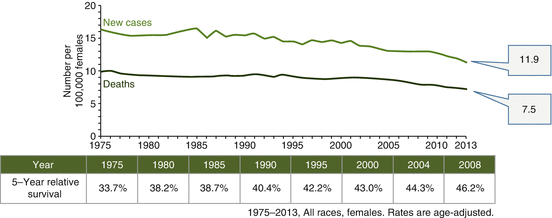
Common types of cancer | Estimated new cases 2016 | Estimated deaths 2016 |
|---|---|---|
1 Breast cancer (female) | 246,660 | 40,450 |
2 Lung and bronchus cancer | 224,390 | 158,080 |
3 Prostate cancer | 180,890 | 26,120 |
4 Colon and rectum cancer | 134,490 | 49,190 |
5 Bladder cancer | 76,960 | 16,390 |
6 Melanoma of the skin | 76,380 | 10,130 |
7 Non-Hodgkin lymphoma | 72,580 | 20,150 |
8 Thyroid cancer | 64,300 | 1,980 |
9 Kidney and renal pelvis cancer | 62,700 | 14,240 |
10 Leukemia | 60,140 | 24,400 |
― | ― | ― |
17 Ovarian cancer | 22,280 | 14,240 |

Fig. 1.1
Trends of age-adjusted incidence rate, mortality, and 5-year relative survival rate: ovarian cancer (From ref. 7)
The median age of women diagnosed with ovarian cancer is 63 years. As for the age-specific incidence, 1.3% of women with ovarian cancer are diagnosed at 19 years or younger, 3.8% at 20–34 years, 6.9% at 35–44 years, 18.6% at 45–54 years, 24.2% at 55–64 years, 21.3% at 65–74 years, 15.9% at 75–84 years, and 8.0% at 85 years or older (Fig. 1.2). Thus, the prevalence of ovarian cancer increases with age, and it increases rapidly from the age of 45 years. Patients who are 45 or older comprise 88% of the total number of patients, with a peak at 55–64 years. These points suggest that aging is an important factor in the development of ovarian cancer.
As for racial/ethnic background, the age-adjusted incidence rate per 100,000 females is 12.5 for whites, 9.6 for blacks, 9.3 for Asian/Pacific islanders, 10.4 for American Indians/Alaskan natives, 10.6 for Hispanics, and 12.0 for non-Hispanics. Thus, ovarian cancer incidence rate tends to be lower among blacks and Asians, while it is higher among whites and non-Hispanics (Fig. 1.3).
Ovarian cancer is confined to the ovary at diagnosis in 15% of patients, while it has spread to regional lymph nodes in 19% and has spread or metastasized beyond the primary site in 60% (the details are unknown in 6%), indicating that more than half of all patients have advanced disease at diagnosis (Fig. 1.4). In older women, ovarian cancer is diagnosed at a relatively more advanced stage than in young women.
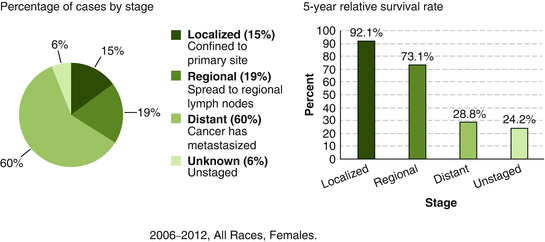

Fig. 1.4
Percentage of cases and 5-year relative survival rate by stage at diagnosis: ovarian cancer (From ref. 7)
On the other hand, the trends of cancer prevalence and mortality in Japan are reported by the Cancer Registry and Statistics in Cancer Information Service, National Cancer Center, Japan [9], and the annual report of the Committee on Gynecologic Oncology, Japan Society of Obstetrics and Gynecology (JSOG) [10]. As of 2012, the age-adjusted incidence rate of ovarian cancer was 8.3 per 100,000 females. That of all sites of female cancer was 265.8 per 100,000 females, and that of breast cancer was 64.3 per 100,000 females, which was the highest in female cancers. Ovarian cancer is ranked seventh among all sites of female cancers and accounting for 3.1% of new cancers. In Japan, the annual age-adjusted incidence rate of ovarian cancer has doubled in these 30 years. Patients aged 60–69, 50–59, and 40–49 years accounted for 26.9%, 24.6%, and 21.5%, respectively, of all patients whose treatment was initiated in 2013. Women in their 50s and 60s were predominantly affected by ovarian cancer, same as the report on SEER. The distribution of surgical stages is as follows: stage I (confined to primary site) accounted for 42.2%, stage II (spread to pelvic cavity) accounted for 9.8%, stage III (spread to regional lymph nodes and/or peritoneal cavity) accounted for 28.2%, and stage IV (metastasize to distant organs) accounted for 8.3% of all patients. Neoadjuvant chemotherapy was administered to 10.9% of patients.
1.4 Current Status and Changes of Ovarian Cancer Mortality
According to SEER [7], the age-adjusted mortality rate of ovarian cancer was 7.5 per 100,000 females in 2009–2013. Based on the 2006–2012 data, the 5-year survival rate of ovarian cancer patients was 46.2%, indicating that more than half of these patients die within 5 years. In the United States, 14,240 patients are predicted to die of ovarian cancer in 2016 (Table 1.2). Ovarian cancer accounts for 2.4% of all cancer deaths, which is high in proportion to the number of patients with this tumor. When compared to the 5-year survival rate of 89.7% for breast cancer and the 40,450 estimated annual deaths (21.5 per 100,000 females) from this cancer, which has the highest estimated annual incidence, the higher risk of death from ovarian cancer becomes obvious. However, the annual age-adjusted mortality due to ovarian cancer is decreasing, as it was 9.8 per 100,000 females in 1975, 9.3 in 1990, 8.7 in 2004, and 7.5 in 2013. In addition, the 5-year survival rate is increasing, since it was 33.7% in 1975, 40.4% in 1990, and 46.2% in 2008 (Fig. 1.1). This improvement is thought to be due to advances in operative treatment and to the development and standardization of novel chemotherapy regimens.
The median age at which patients die of ovarian cancer is 70 years. As for the age-specific mortality, 0.1% of patients die at 19 years or younger, 0.7% at 20–34 years, 2.3% at 35–44 years, 10.4% at 45–54 years, 21.4% at 55–64 years, 25.8% at 65–74 years, 25.0% at 75–84 years, and 14.3% at 85 years or older (Fig. 1.2). The ovarian cancer mortality is in proportion to the incidence of this cancer and thus increases with age to a peak at 55–64 years.
With respect to the influence of racial/ethnic background, the age-adjusted mortality per 100,000 females is 7.8 for whites, 6.5 for blacks, 4.5 for Asian/Pacific islanders, 6.7 for American Indians/Alaskan natives, 5.5 for Hispanics, and 7.7 for non-Hispanics. Thus, mortality tends to be lower in Asian/Pacific islanders and Hispanics compared with the incidence of this cancer (Fig. 1.3).
The 5-year survival rate at the time of diagnosis of ovarian cancer is 92.1% if the tumor is confined to the ovary, 73.1% if it has spread to regional lymph nodes, 28.8% if it has spread or metastasized beyond the region, and 24.2% when the details are unknown. Therefore, the prognosis is poorer as the disease becomes more advanced, and the overall prognosis is poor because many patients have advanced disease at the time of diagnosis (Fig. 1.4).
According to the Cancer Registry and Statistics in Japan [9], the age-adjusted mortality rate of ovarian cancer was 3.1 per 100,000 females in 2014. That of all sites of female cancer is 63.0 per 100,000 females, and that of breast cancer is 8.9 per 100,000 females. Ovarian cancer is ranked eighth among all sites of female cancers and accounting for 4.9% of all female cancer deaths. Based on the 2006–2008 data, the 5-year survival rate of ovarian cancer patients was 58.0%. Those in 1993–1996, in 1997–1999, in 2000–2002, and in 2003–2005 are 49.4%, 52.0%, 53.3%, and 55.0%, respectively. The 5-year survival rate also has been gradually improving in Japan. According to the annual report of JSOG for patients whose treatment was initiated in 2008 [10], the 5-year survival rates were 90.5% in stage I patients, 73.3% in stage II patients, 47.8% in stage III patients, and 30.2% in stage IV patients. Patients with serous carcinoma had a significantly poorer prognosis compared with those with mucinous carcinoma, endometrioid carcinoma, and clear cell carcinoma.
1.5 International Comparison of Ovarian Cancer Incidence Rate and Mortality
The International Agency for Research on Cancer (IARC), which is an agency of the World Health Organization (WHO), has reported the trends for the incidence and death from ovarian cancer based on data from 184 countries [11]. As of 2012, the age-adjusted regional ovarian cancer incidence rate is 8.0–9.9 per 100,000 females in Europe, North America, and Oceania versus 4.8–5.6 in Africa, South America, and Asia, being somewhat higher in Western countries (Fig. 1.5). Also as of 2012, the age-adjusted regional ovarian cancer mortality is 4.9–5.4 per 100,000 females in Europe, North America, and Oceania versus 3.0–3.8 in Africa, South America, and Asia, showing a relatively higher number of deaths in South America and Africa compared to the incidence in these regions (Fig. 1.5). The age-adjusted incidence rate in developed countries is 9.1 per 100,000 females, and it is 5.0 per 100,000 females in developing countries, while the age-adjusted mortality is 5.0 and 3.1 per 100,000 females, respectively, suggesting higher incidence rate and mortality from ovarian cancer in developed countries.

